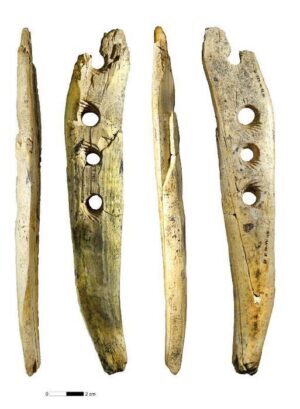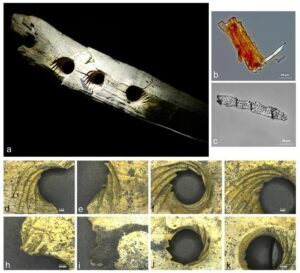
AMERICAN ASSOCIATION FOR THE ADVANCEMENT OF SCIENCE (AAAS)—A baton made of mammoth ivory discovered in a German cave appears to be a tool that was used more than 35,000 years ago to make sturdy rope, according to a new analysis* by Nicholas Conard and Veerle Rots. The tool offers a glimpse at how people of the early Upper Paleolithic may have aligned and combined fibers to create multi-strand rope that could be used in various technologies. The baton was found in pieces at Hohle Fels Cave in southwestern Germany, among other artifacts attributed to the Aurignacian archaeological culture in Central Europe. Radiocarbon dating of animal bones showing signs of human modification places the collection of artifacts between 40,000 and 35,000 years old, the researchers conclude. The baton itself has four holes, with each hole containing precisely carved spiraling grooves. To learn more about the baton’s use, Conard and Rots looked for traces of wear and plant residues in the perforations of the Hohle Fels tool and in a similar artifact from another German archaeological site from the period. The wear and residues found in both artifacts suggest that fibers were pulled through the holes, guided by the grooved pattern. The researchers then reproduced the perforated tool and tested deer sinew and a variety of plant fibers through its holes, finding that the tool helped to straighten, align, and combine multiple strands of fiber. The experiments required several people to operate the tool, which suggests that making rope in Aurignacian times may have been a cooperative effort, Conard and Rots note.
___________________________

Ivory perforated baton from Hohle Fels Cave, southwestern Germany with four views. Conard et al, Sci. Adv. 10, eadh5217 (2024)
___________________________

Macro- and microscopic images of the ivory perforated baton and residue evidence. Conard et al, Sci. Adv. 10, eadh5217 (2024)
___________________________
Article Source: AAAS news release
*Rope making in the Aurignacian of Central Europe more than 35,000 years ago, Science Advances, 31-Jan-2024. www.science.org/doi/10.1126/sciadv.adh5217
__________________
Advertisement

See the incredible archaeology, architecture, and art of northern Spain. A unique tour with special expert guides and lecturers through the collaboration of Popular Archaeology Magazine and Stone & Compass Tours. Not to be missed. Read More About It: https://popular-archaeology.com/article/northern-spains-triple-a-archaeology-architecture-and-art/.
__________________




